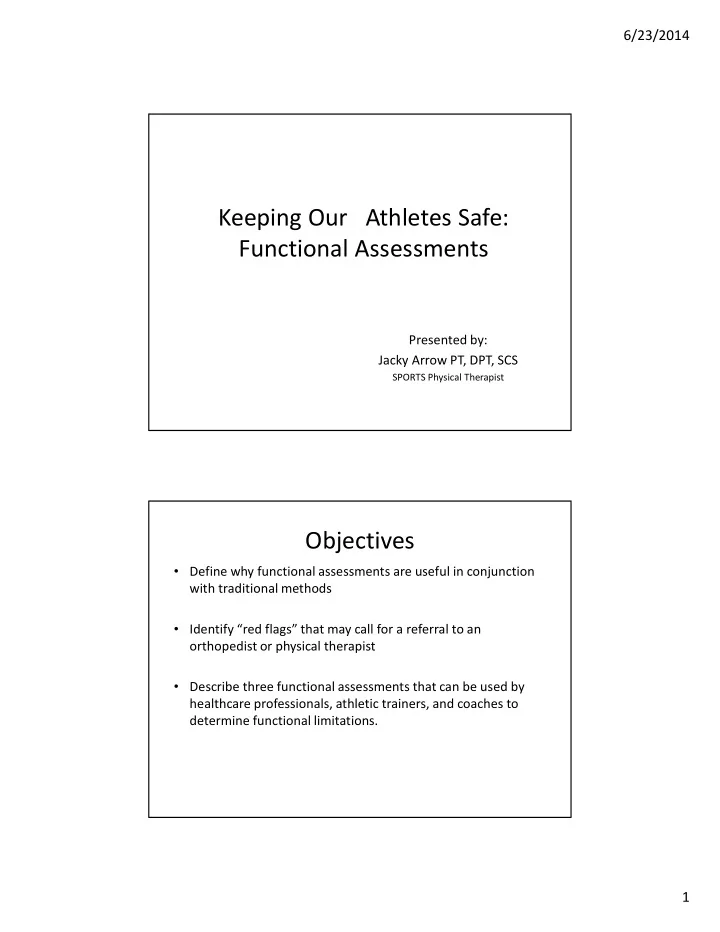

6/23/2014 Keeping Our Athletes Safe: Functional Assessments Presented by: Jacky Arrow PT, DPT, SCS SPORTS Physical Therapist Objectives • Define why functional assessments are useful in conjunction with traditional methods • Identify “red flags” that may call for a referral to an orthopedist or physical therapist • Describe three functional assessments that can be used by healthcare professionals, athletic trainers, and coaches to determine functional limitations. 1
6/23/2014 What is it? • Looking at how the athlete moves • Quality not quantity When would I use these? School Nurse Coach Athletic Trainer & • Pre-participation • Meeting your Physical screens athletes Therapist • In nurse’s office • During practice • Pre-participation screens • Return to sport 2
6/23/2014 All the puzzle pieces… Subjective Reports Subjective Reports • Subjective Reports – Open to interpretation 3
6/23/2014 All the puzzle pieces… ROM, Subjective Strength, Reports Flexibility ROM, Strength, Flexibility • ROM, Strength, Flexibility – Isolated to body segment – Important to know any major limitations – However, do not have strong correlation to functional ability 1 4
6/23/2014 All the puzzle pieces… ROM, Subjective Strength, Reports Flexibility Performance Tests Performance Tests • Performance Tests – Do not evaluate efficiency 4 5
6/23/2014 All the puzzle pieces… ROM, Subjective Strength, Reports Flexibility Functional Performance Tests Assessment All the puzzle pieces… Functional Assessment Create Linked to strength and Full body Quality is injury risk conditioning movement assessed 3,4,5,10 programs 2,8,13,14 6
6/23/2014 Red Flags • When to refer? – Injury or pain – Movement abnormalities Functional Assessments • Lateral Plank • Broad Jump • Functional Movement Screen – 7 tests – Indicative of injury risk 3,8 • Deep squat • Active SLR 7
6/23/2014 Lateral Plank • Core strength and endurance 9,14 • Looking at: – Straight body – Neutral spine – Scapular positioning Broad Jump 10 • Ability to produce power, absorb force • Looking at: – Take off position – Landing position – Control in air 8
6/23/2014 Deep Squat 4 • Symmetrical mobility of hips, knees, ankles, thoracic spine, and shoulders • Looking for: – Upright trunk – Past parallel – Knees over feet – Heels on ground Active SLR 5 • Ability to maintain trunk stability during leg movement, as well as hamstring and gastroc-soleus flexibility • Looking for: – Both legs straight – Head down 9
6/23/2014 More resources? • Other FMS tests 4,5 – http://www.functionalmovement.com/ • Modified NFL Combine Tests 10 • Tuck Jumps • Many, many others! Then what? • Corrective exercise – Based on deficits discovered – Can use the test position as an exercise • PEP program – Warm up and strength/conditioning injury prevention program • FIFA 11+ – Warm up and strength/conditioning injury prevention program 10
6/23/2014 References 1) Alcock, G.K.; Validation of the Lower Extremity Functional Scale on Athletic Subjects with Ankle Sprains. Physiotherapy Canada. 2002: 54(4): 223-240. 2) Burton, L., Kiesel, K., & Cook, G. (2004). Mobility screening for the core: Interventions. Athletic Therapy Today , 9(6), 52-57 3) Chorba, R. S., Chorba, D. J., Bouillon, L. E., Overmyer, C. A., & Landis, J. A. (2010). Use of a functional movement screening tool to determine injury risk in female collegiate athletes. North American journal of sports physical therapy: NAJSPT , 5 (2), 47. 4) Cook, G., Burton, L., & Hoogenboom, B. (2006). Pre-participation screening: The use of fundamental movements as an assessment of function–part 1. North American journal of sports physical therapy: NAJSPT , 1 (2), 62. 5) Cook, G., Burton, L., & Hoogenboom, B. (2006). Pre-participation screening: The use of fundamental movements as an assessment of function–Part 2. North American journal of sports physical therapy: NAJSPT , 1 (3), 132. 6) Kiesel, K., Burton, L., & Cook, G. (2004). Mobility screening for the core. Athletic Therapy Today , 9 (5), 38-41. 7) Kiesel, K., Burton, L., & Cook, G. (2005). Mobility screening for the core, part 3: Implications for athletic low back pain. Athletic Therapy Today , 10 (1), 36-39. References, cont’d 8) Kiesel, K., Plisky, P., & Butler, R. (2011). Functional movement test scores improve following a standardized off-season intervention program in professional football players. Scandinavian journal of medicine & science in sports , 21 (2), 287-292. 9) McGill, S. M., Childs, A., & Liebenson, C. (1999). Endurance times for low back stabilization exercises: clinical targets for testing and training from a normal database. Archives of physical medicine and rehabilitation , 80 (8), 941-944. 10) Myer, G. D., Schmitt, L. C., Brent, J. L., Ford, K. R., Barber Foss, K. D., Scherer, B. J., ... & Hewett, T. E. (2011). Utilization of modified NFL combine testing to identify functional deficits in athletes following ACL reconstruction. journal of orthopaedic & sports physical therapy , 41 (6), 377-387. 11) Olsen, O. E., Myklebust, G., Engebretsen, L., Holme, I., & Bahr, R. (2005). Exercises to prevent lower limb injuries in youth sports: cluster randomised controlled trial. Bmj , 330 (7489), 449. 12) Sanders, B., Blackburn, T. A., & Boucher, B. (2013). PREPARTICIPATION SCREENING–THE SPORTS PHYSICAL THERAPY PERSPECTIVE. International journal of sports physical therapy , 8 (2), 180. 13) Soligard, T., Myklebust, G., Steffen, K., Holme, I., Silvers, H., Bizzini, M., ... & Andersen, T. E. (2008). Comprehensive warm-up programme to prevent injuries in young female footballers: cluster randomised controlled trial. BMJ: British Medical Journal , 337 . 14) Wilkerson, G. B., Giles, J. L., & Seibel, D. K. (2012). Prediction of core and lower extremity strains and sprains in collegiate football players: a preliminary study. Journal of athletic training , 47 (3), 264. 11
6/23/2014 Thank you! 12
Recommend
More recommend